This is a great, traditional South Louisiana Oyster Dressing. There's nothing complicated about combining lots of onions, celery, and parsley with traditional seasonings, rich poultry flavor, and tons of fresh oysters laced together with traditional day-old French bread. If you're looking for a traditional Oyster Dressing, this simple no-angst recipe welcomes you to South Louisiana!
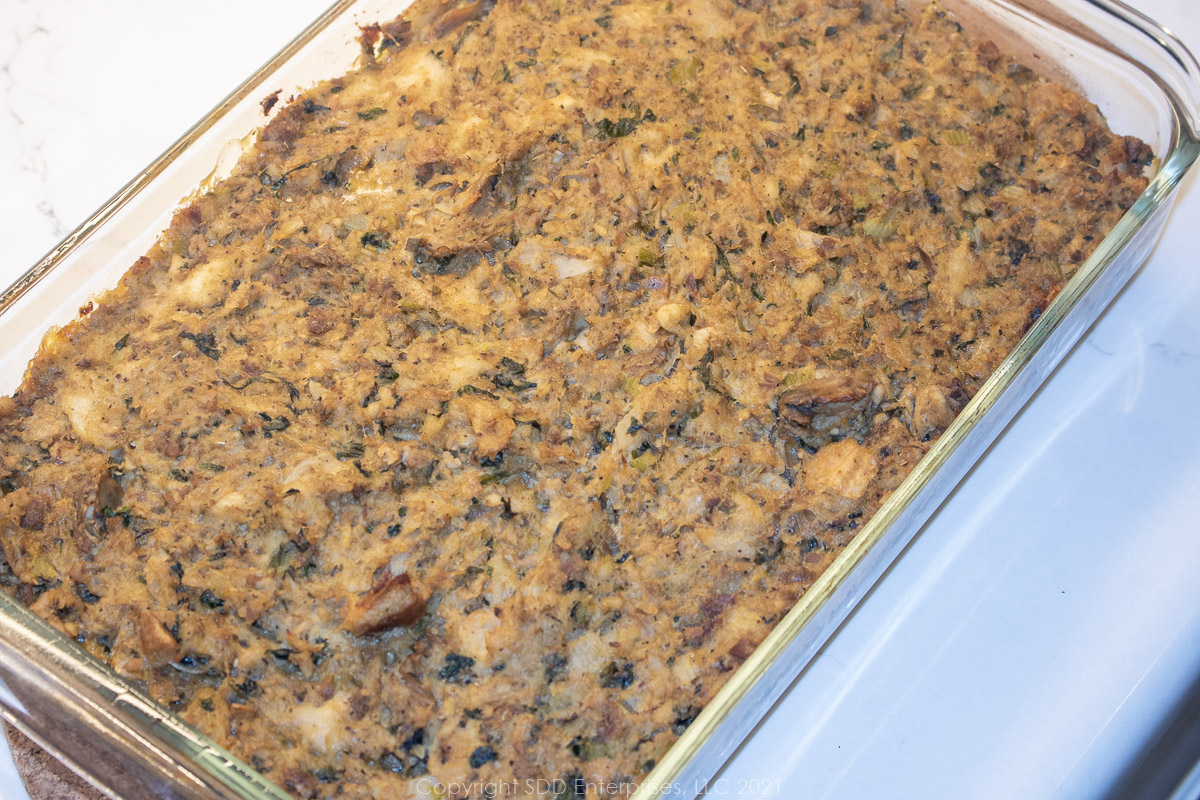
This post is not sponsored, but you will find affiliate links on this page. As an Amazon Associate, I earn from qualifying purchases. The price you pay as a consumer does not change, but I may make a small commission based on your purchase.
If you want to just skip to the recipe, click the "Jump To Recipe" button above or the Recipe link below and you’ll go right there without having to scroll through my article.
Jump to:
South Louisiana Tradition
Family traditions in Southern Louisiana usually center around food which helps maintain strong bonds and sustain family values for future generations. The holidays are a special time for families that have grown and spread beyond the region. Your momma's or her momma's recipes serve as beacons for family members anxious to connect. Of all the special recipes, it's the dressing or stuffing that people remember and yearn for. In South Louisiana, that usually means oyster dressing. I've introduced readers to some of my mother-in-law's holiday recipes which only begin to form the foundation of our family traditions. This Oyster Dressing Recipe is perhaps Grammie's (as she is known to more grandkids and great-grandkids than I can count) most popular family favorite. Talk about no-angst and letting the ingredients do the talking, this recipe will give you a hint of why oyster dressing is so popular in South Louisiana. You'll be adding this recipe to your Holiday feasts for years to come. You can check out some of Grammie's other great recipes later in this article.
Here’s What You Need
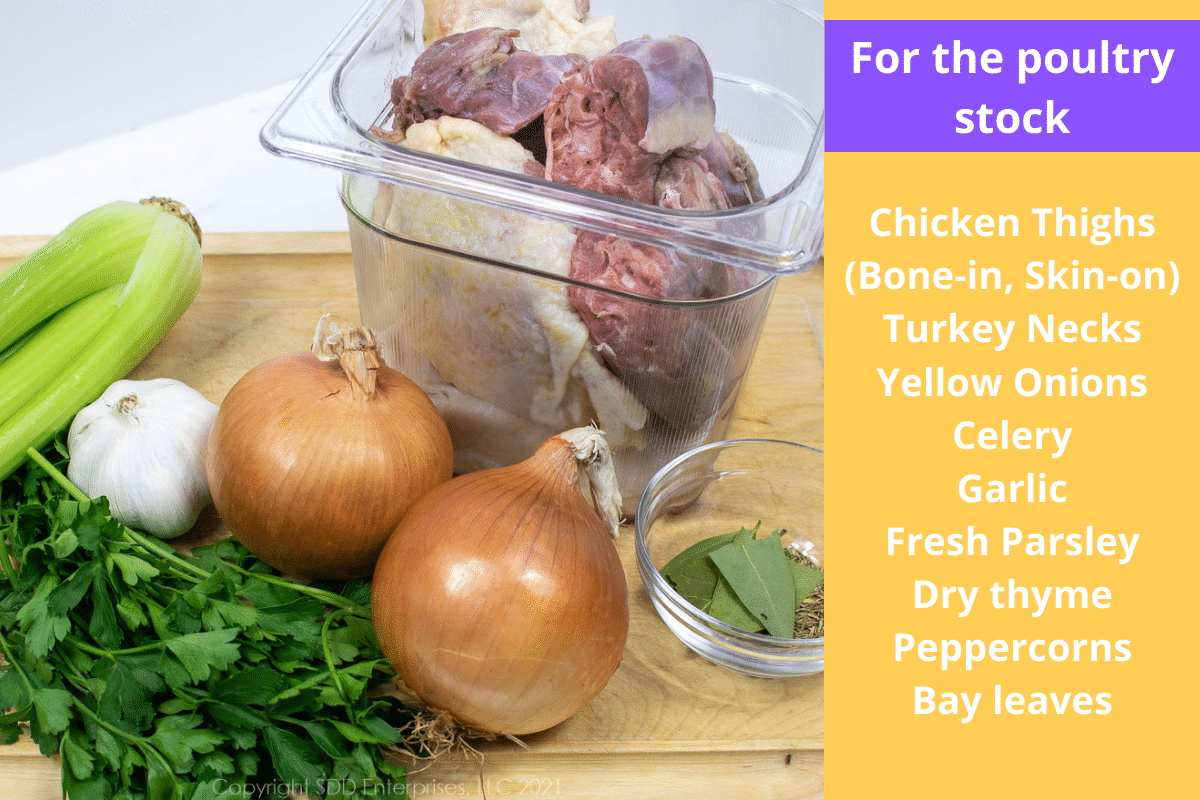
Lagniappe Tip: Make sure to use dark chicken or turkey meat for this part because that adds much more flavor and fat than white meat.
Full disclosure: There are no thyme or bay leaves in Grammie's original recipe but I couldn't resist adding a little of those to the stock. We don't use much of the stock in this recipe, so don't tell Grammie! She'll call me a couyon and hit me with that big wooden spoon she gave me for just such an occasion!
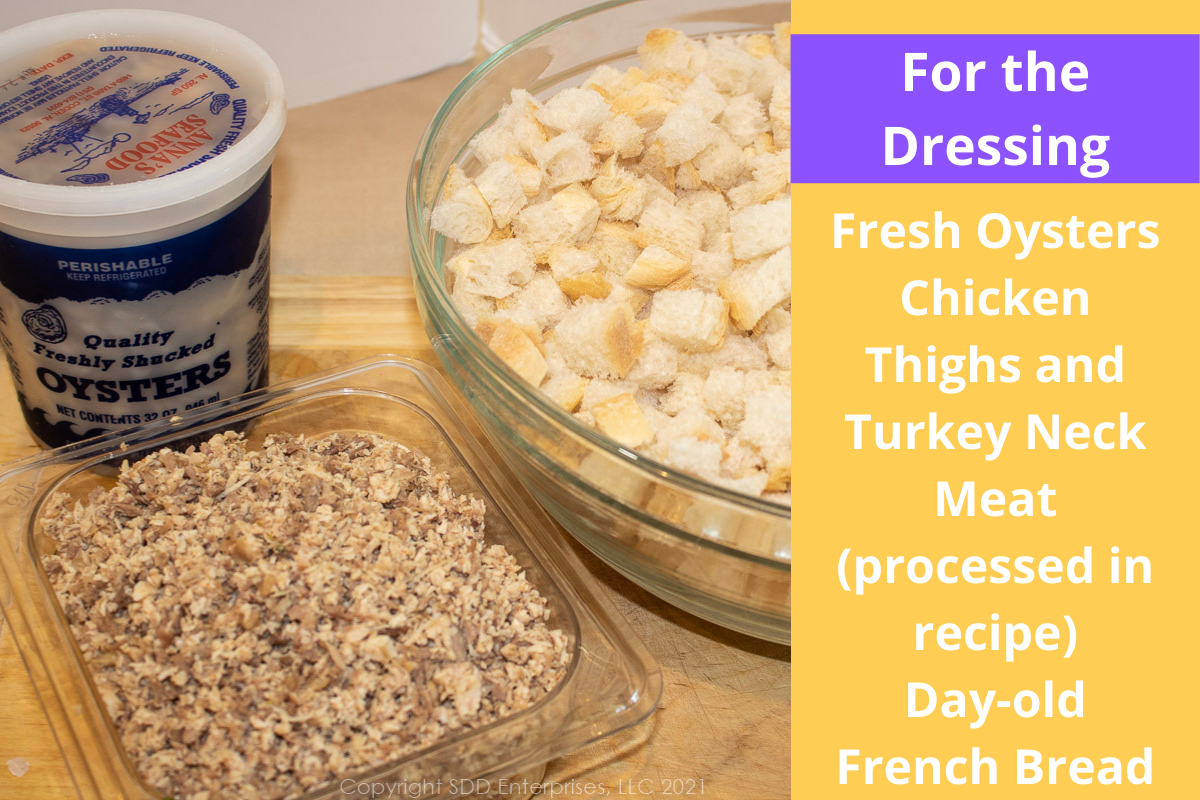
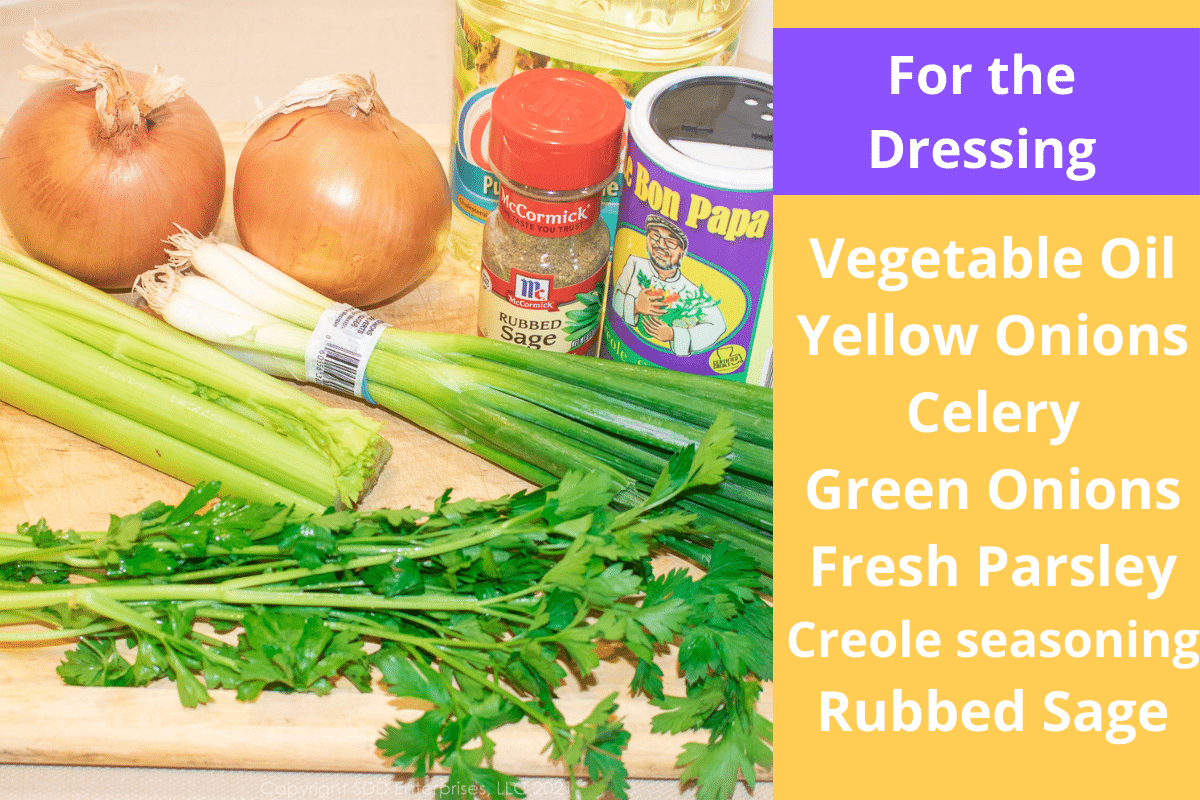

Equipment
Here is some of the equipment I used in making this recipe:
This post is not sponsored, but you will find affiliate links on this page. As an Amazon Associate, I earn from qualifying purchases. The price you pay as a consumer does not change, but I may make a small commission based on your purchase.
Stockpot, Dutch Oven, Cutting Boards, Chef's Knife, Prep Bowls (Cambro), Prep Bowls (Glass), Glass Measuring Cups, Metal Measuring Cups and Spoons, Small Food Processor, Kitchen Strainer, Garni Bags, Baking Dish
Here’s What You Do
First...you have a beer. There seems to be a lot going on here, but it's not as complicated as it seems. Still, that's all the more reason to properly prepare the ingredients, equipment, and most of all the cook. Read the recipe all the way through to see what you need and what you will do with all of it. This recipe can be made in stages the day before. Read more about that in the Hints and Tips section. Mise en place is extra helpful for this recipe.
Mise en Place
We will prepare ingredients for both the stock and poultry as well as the dressing. Either, or both, can be done the day before.
Prep for the stock/poultry
- Cut the onion in half through the ends.
- Chop the celery into 2 or 3-inch pieces.
- Slice the garlic head in half crossway.
- Place the thyme, broken bay leaves, and peppercorns in a garnie bag.
- Tie the parsley together with butcher twine.
- Rinse the thighs and pat dry with a paper towel.
Check out the Hints and Tips (FAQ) section if you don't want to mess with making a stock.
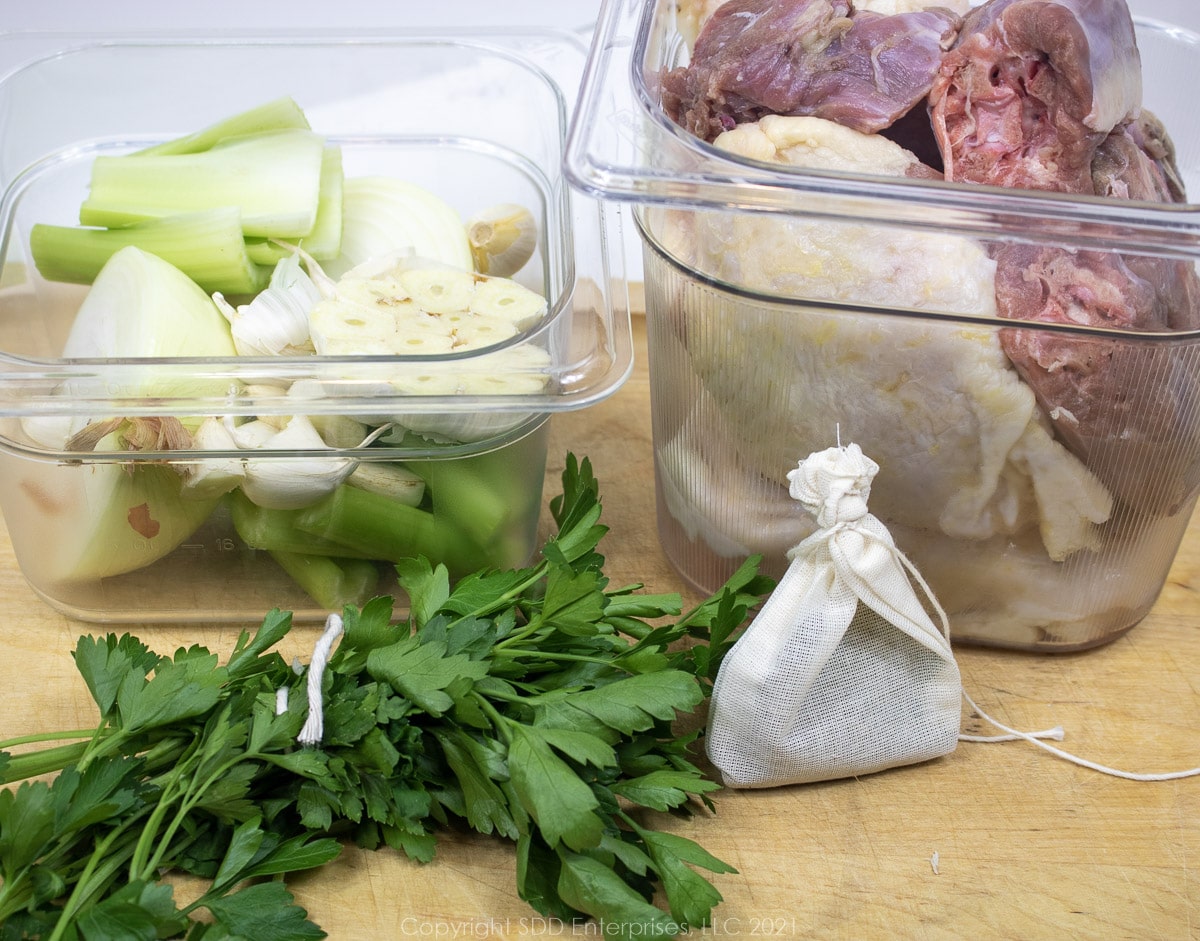
Prep for the dressing
- Drain the oysters and retain the liquid.
- Cut the French bread into ¼ - ½ inch cubes.
- Roughly chop all vegetables and place ingredients that are added together in the same prep bowl.
- Combine all the Herb and Spice ingredients except the ground sage into one prep bowl. Place the sage in a separate bowl.
- When stock is ready, set aside 1 cup. The remainder should be frozen for other recipes.
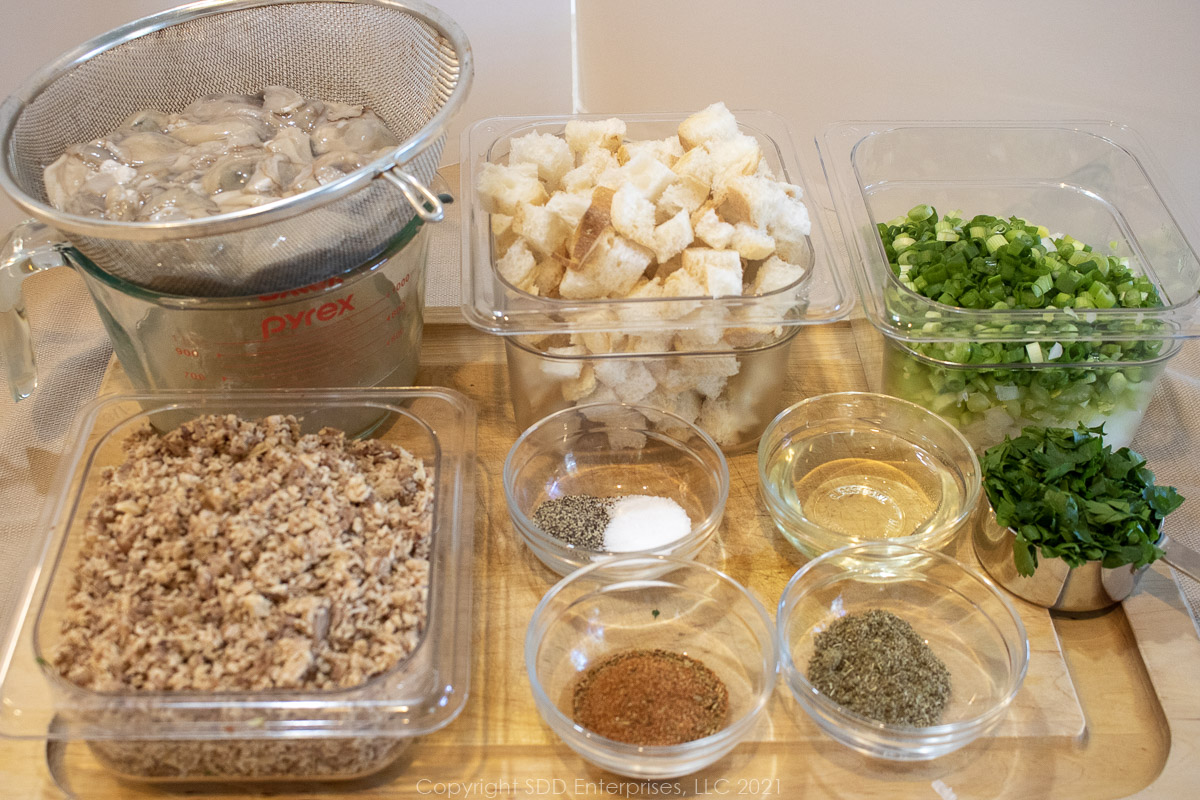
Cooking the poultry and stock
What happens in this step? The rich flavor begins here by preparing the chicken thighs and turkey neck meat, which combine for foundational flavor. The stock is rich and delicious and will be used to a lesser degree, thus leaving you some great stock for other recipes.
Lagniappe Tip: This step can be done the day before and kept in the refrigerator until needed. See the Hints and Tips (FAQ) section below.
Brown the chicken thighs, skin side down in a hot stockpot over medium-high heat. Turn the thighs over after 4 or 5 minutes and add the turkey necks. Continue to brown the thighs and necks for about 5 minutes, turning the necks every couple of minutes. Remove the thighs and necks, leaving the rendered chicken fat.
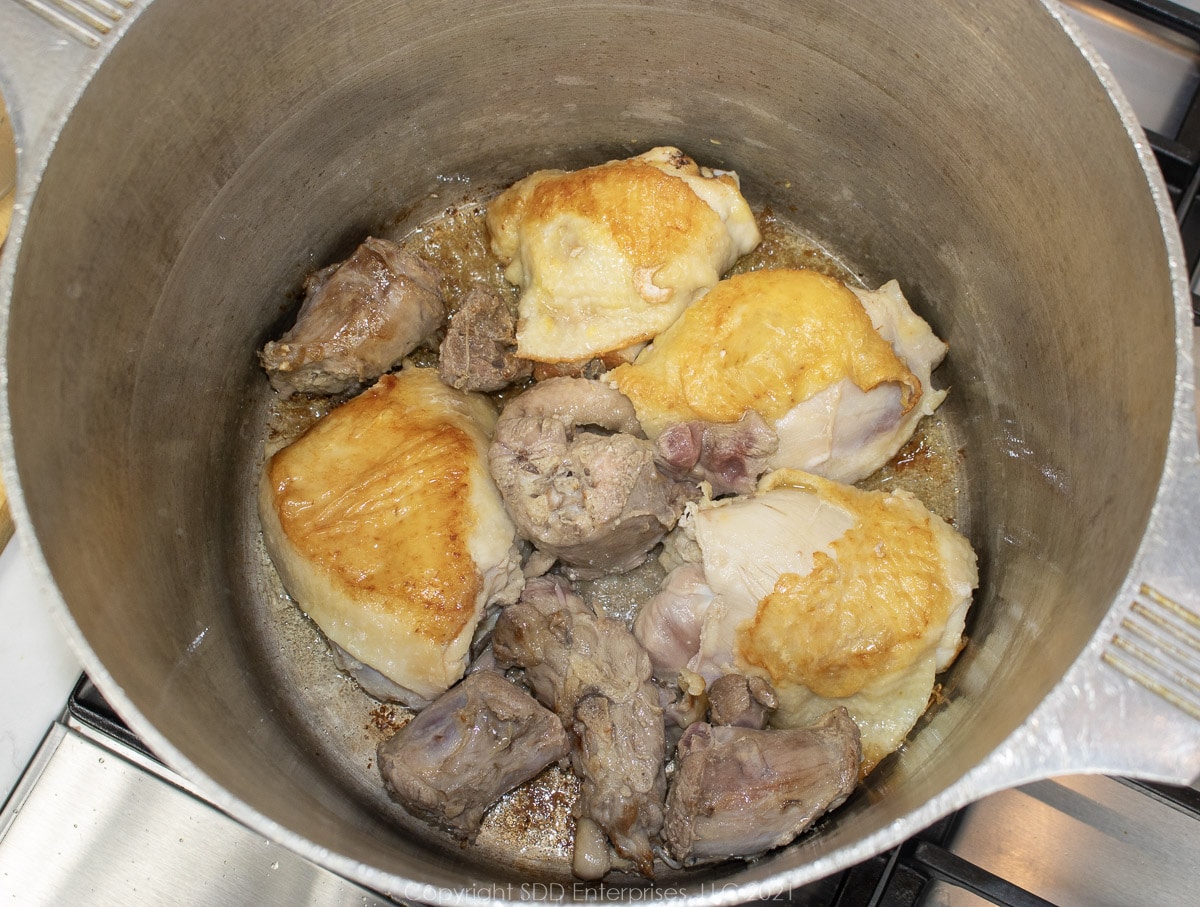
The onions and garlic go into the stockpot, cut side down. Throw in the celery and brown the vegetables for about 5 minutes. Make sure to leave the cut side down the whole time.
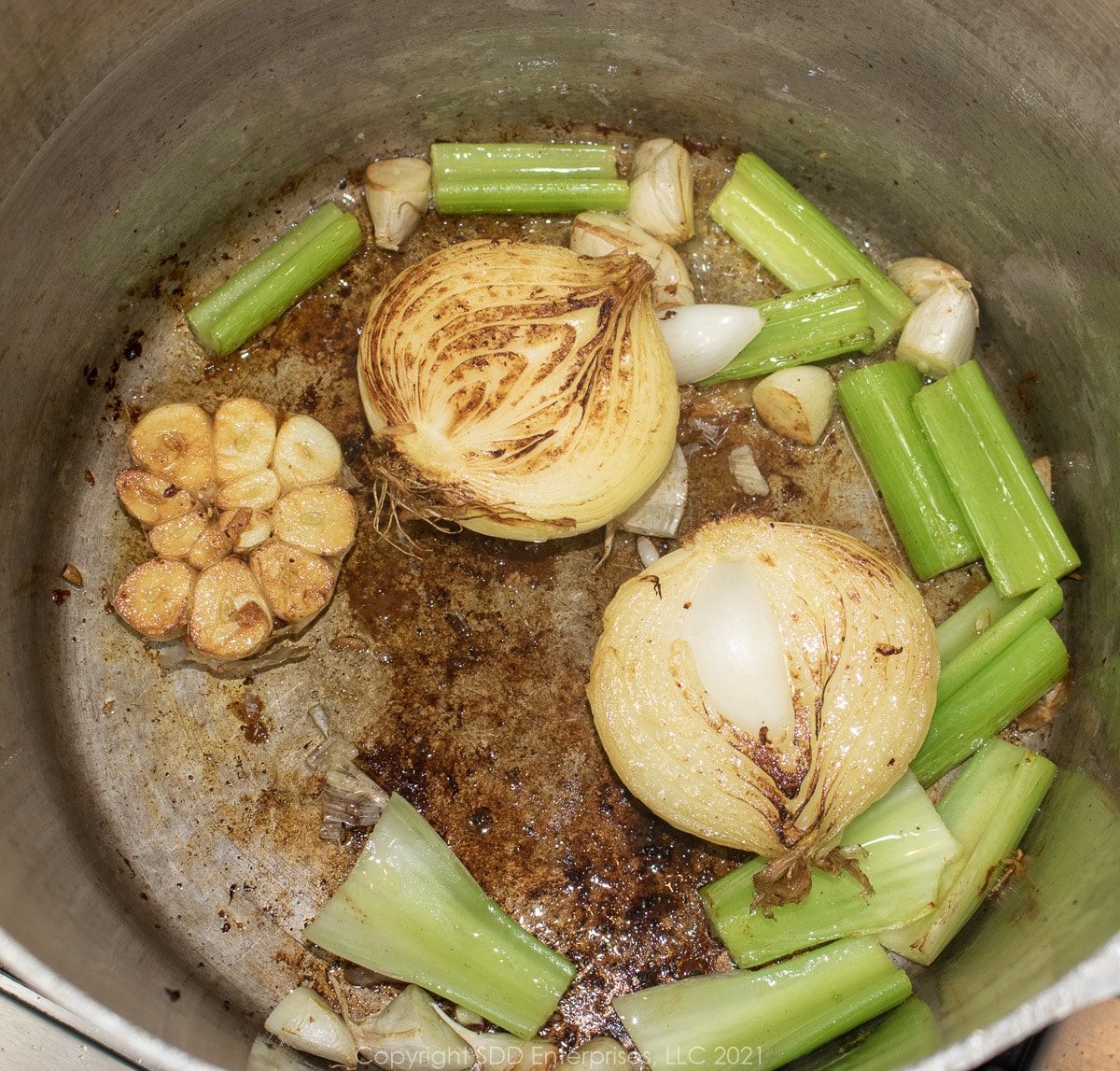
Once the onions and garlic are browned, add the thighs, necks, parsley, and Garni bag. Increase the heat to high and add 8 cups of cold water, stir.
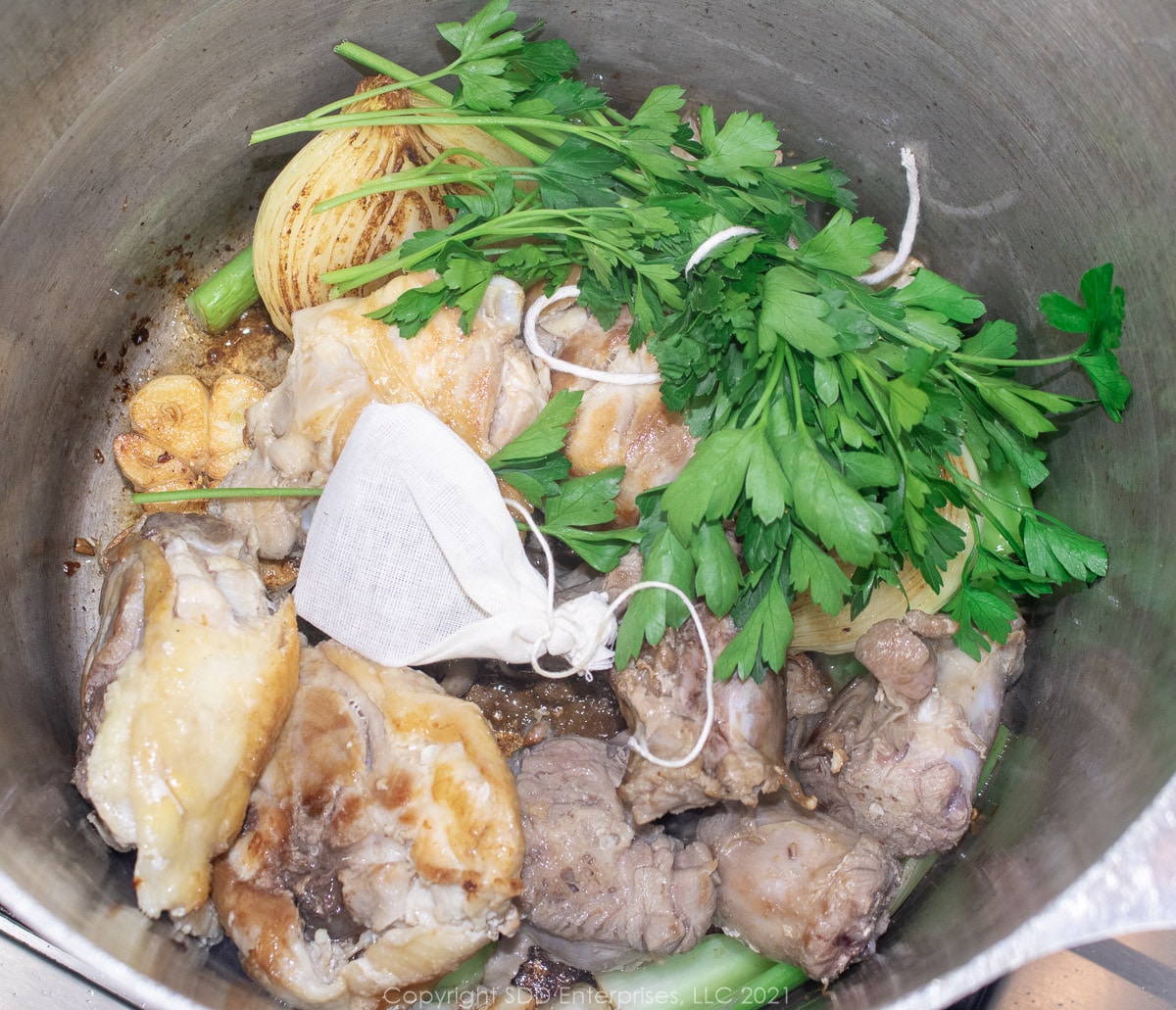
Bring the stockpot to a boil before reducing the heat to a very low simmer.
Lagniappe Tip: After a short time, you will notice some froth or residue on the surface of the stock. These are proteins and impurities from the chicken and turkey. Don't stir those into the stock, just skim it off and discard it. If not removed, it will eventually break down into the stock and make it cloudy. Skimming the impurities and keeping the stock on the lowest possible simmer will make for a more clear finished product.
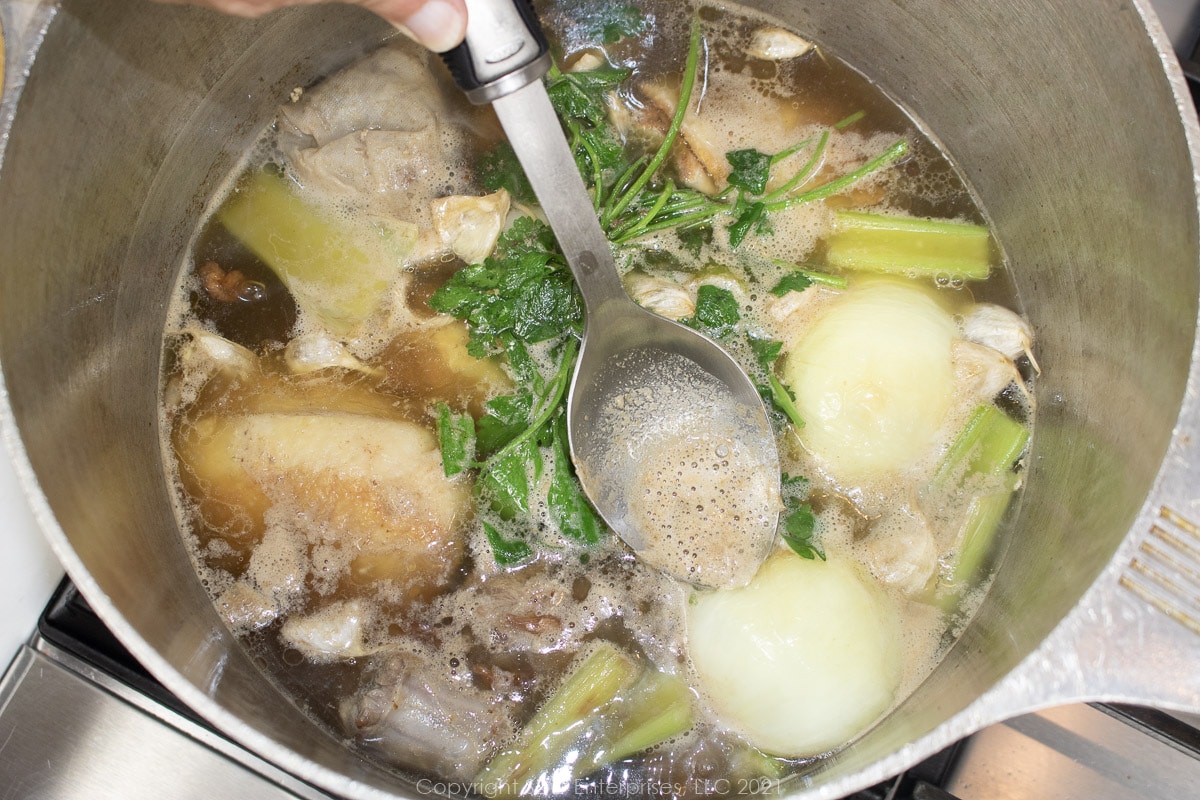
Simmer with the stockpot partially covered for about an hour. Remove the thighs at this time then continue a low simmer for another 30 minutes and it should be done. Remove the necks and let them cool with the thighs.
Allow the stock to cool, then strain it. This should yield about 6 cups of stock. Once the meat has cooled, pull the thigh meat off the bone and pull the turkey meat off of the neck bones. Place that in a small food processor, and sprinkle on some Creole seasoning before pulsing to a fine grind. This should yield 4 to 5 cups of ground poultry meat. Discard the vegetables, bones, and skin. Set the ground poultry and stock aside. Check out the Hints and Tips section below for ideas on straining the stock and grinding the poultry.
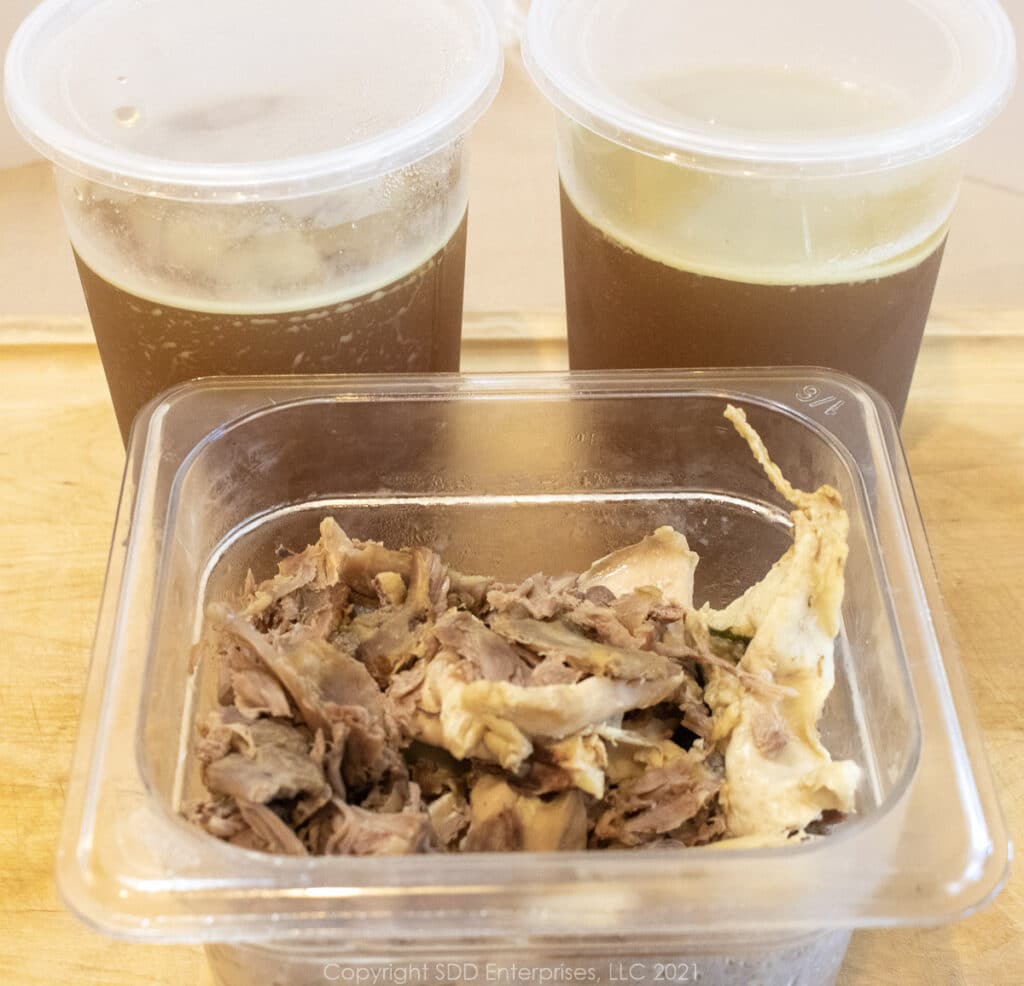
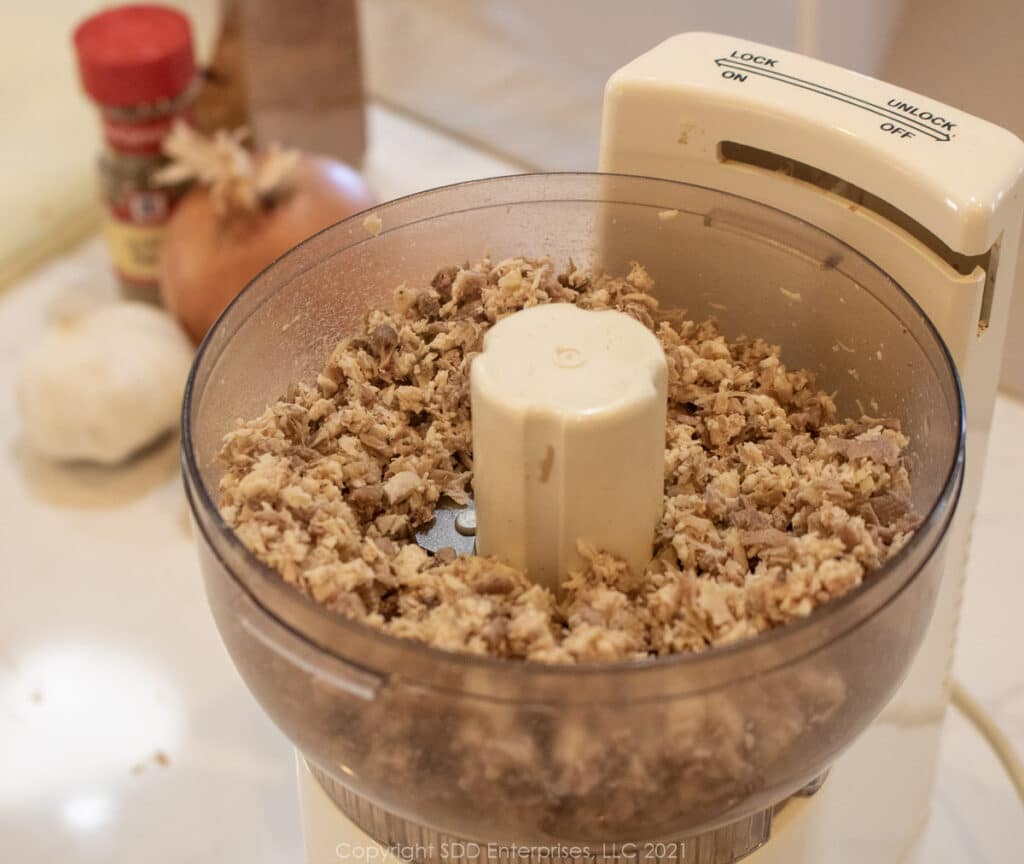
Start the dressing with the veggies and poultry
What happens in this step? In this step, we start to construct the dressing by building the first layer of flavor with the vegetables and poultry,
Add vegetable oil to a Dutch oven over medium-high heat. When hot, add the yellow onions, celery, and green onions. Fry them for about 10 minutes until the yellow onions are translucent. Stir often during this stage so the onions don’t scorch.
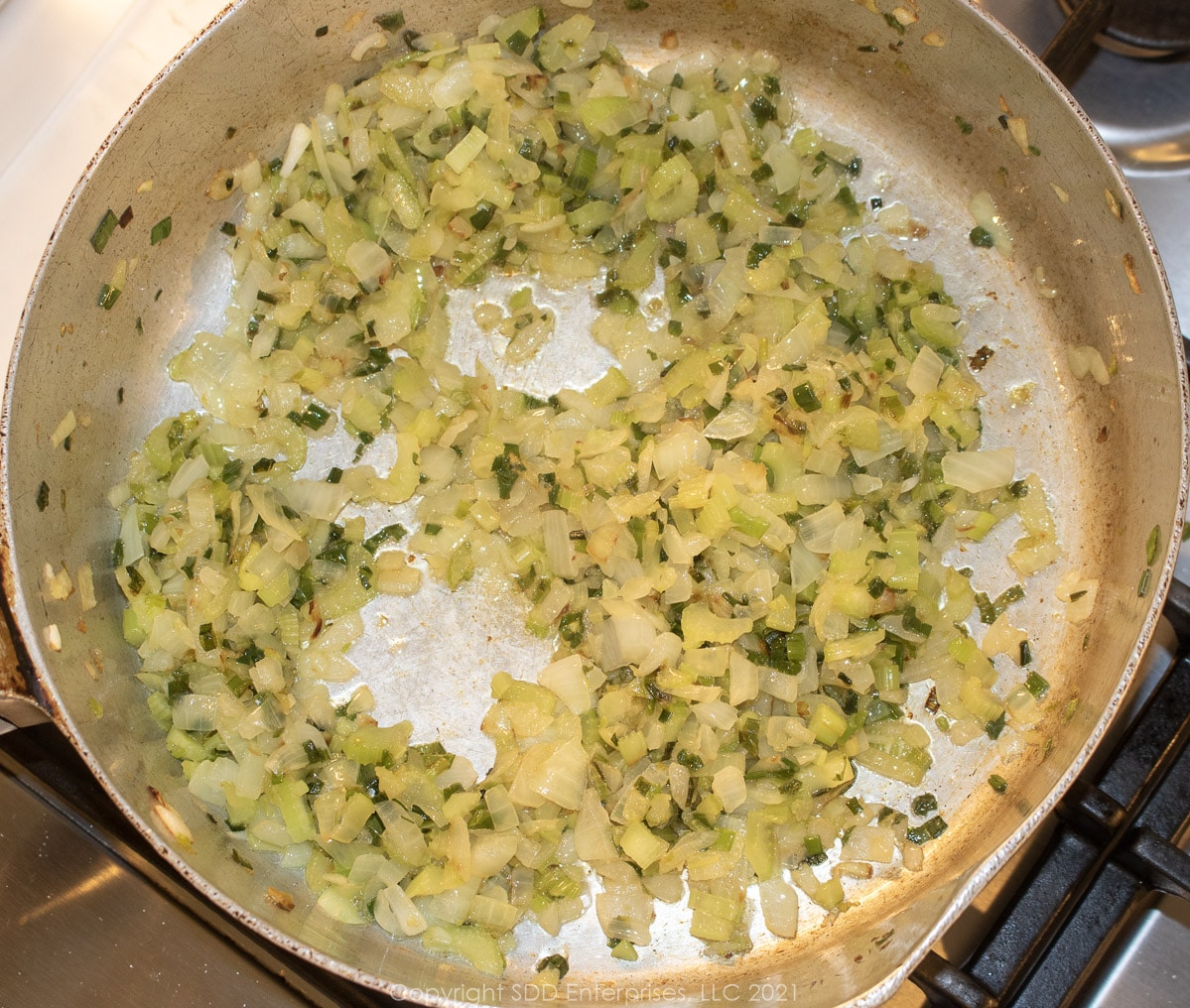
Mix in the ground chicken and turkey and cook for another 10 to 15 minutes, stirring occasionally.
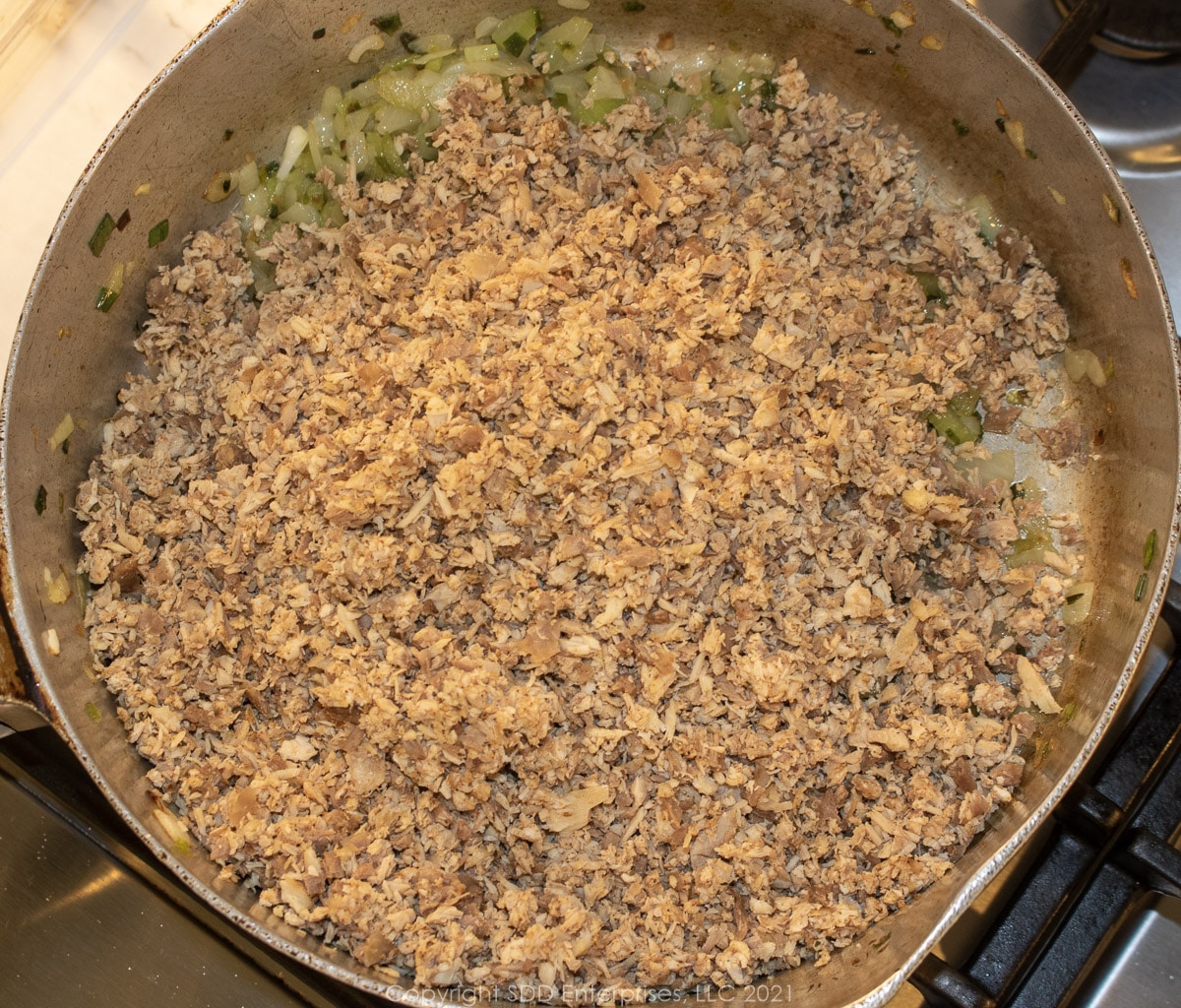
Add all the Herb and Spice Blend except the sage.
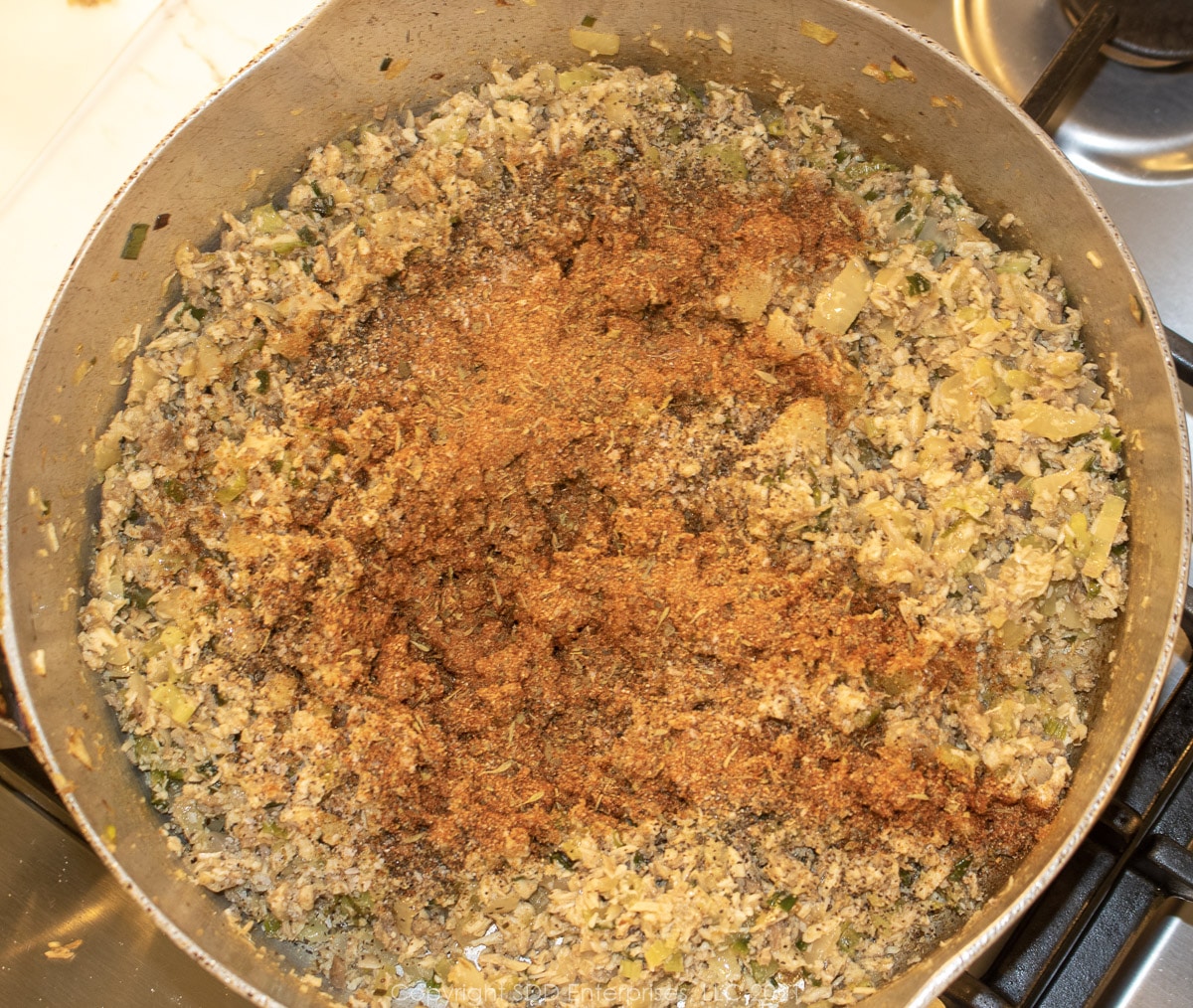
Lagniappe Tip: While the vegetables and meat are simmering, add about 2 to 3 cups of oyster juice to the bread cubes. Save any remaining juice. Mix well and set aside, stirring once or twice. If you don't have enough oyster juice, use some of the reserved stock.
Add oysters and breading
What happens in this step? Oysters provide a subtle, contrasting flavor that drives the whole thing. This is the step where that flavor is established and bound together by the day-old French bread.
After the poultry meat has simmered with the vegetables for about 15 minutes, add the raw oysters (not the juice) and the parsley. Mix completely. Cook everything until the oysters curl up and the liquid reduces, This should only take 5 to 10 minutes.
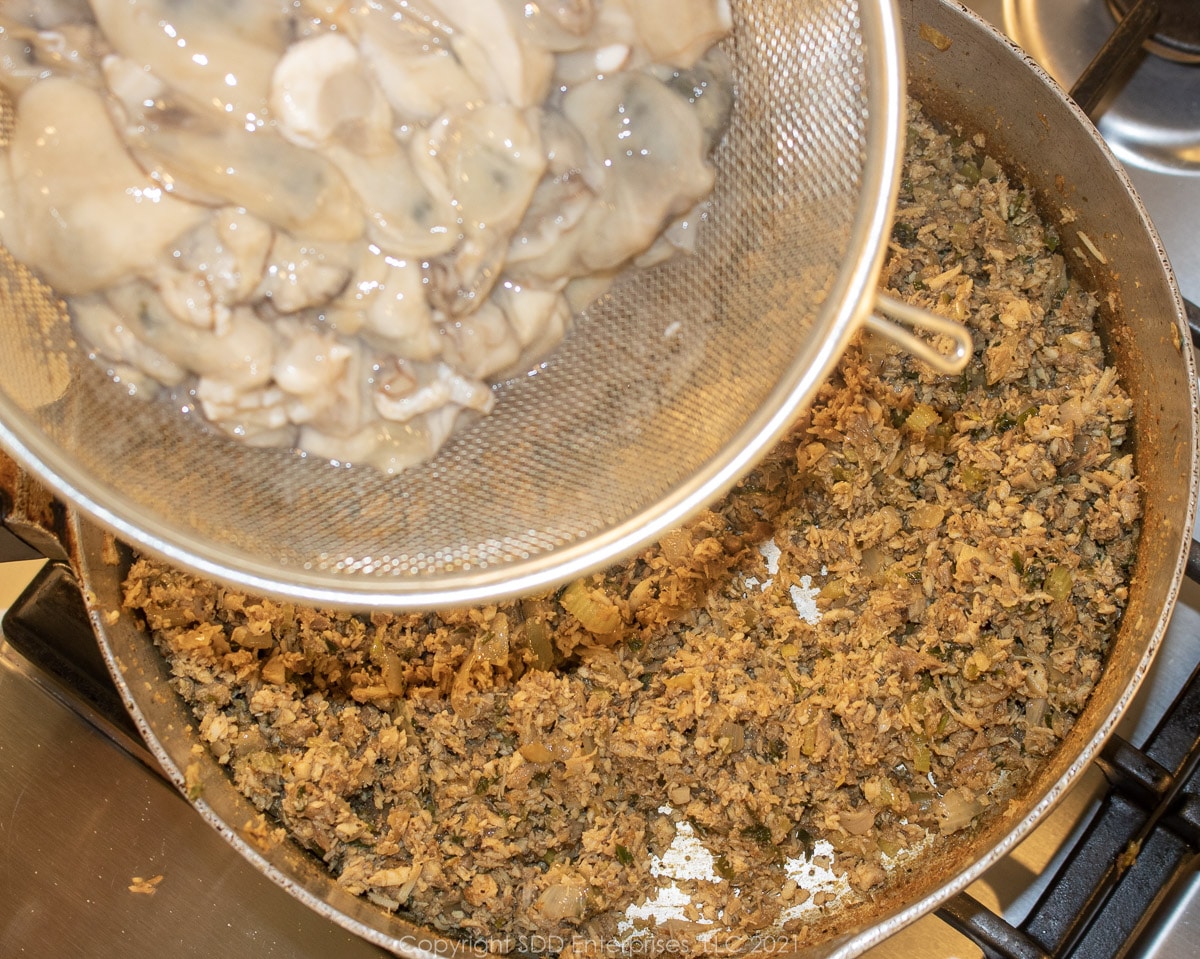
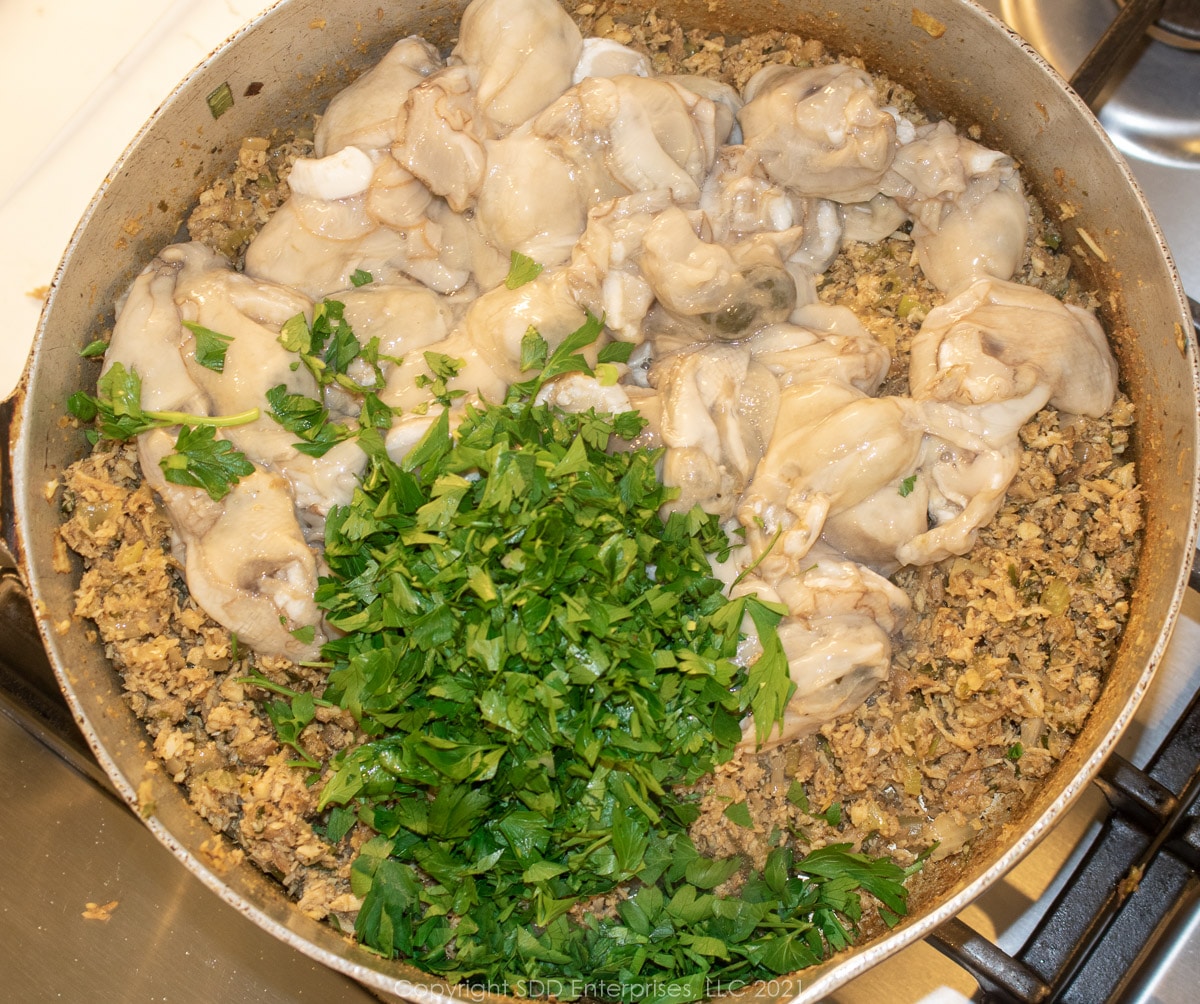
Lagniappe Tip: The oysters will release liquid as they cook, so use that to deglaze the pan, if needed.
Add the soaked bread cubes (make sure to add some of the oyster juice to the bread cubes while you're cooking the poultry meat and veggies) and sage to the vegetables and oysters and mix well to combine. Add the remaining oyster juice (if any) or stock and more bread if needed to achieve the consistency you want. Remain on low heat for about 5 minutes.
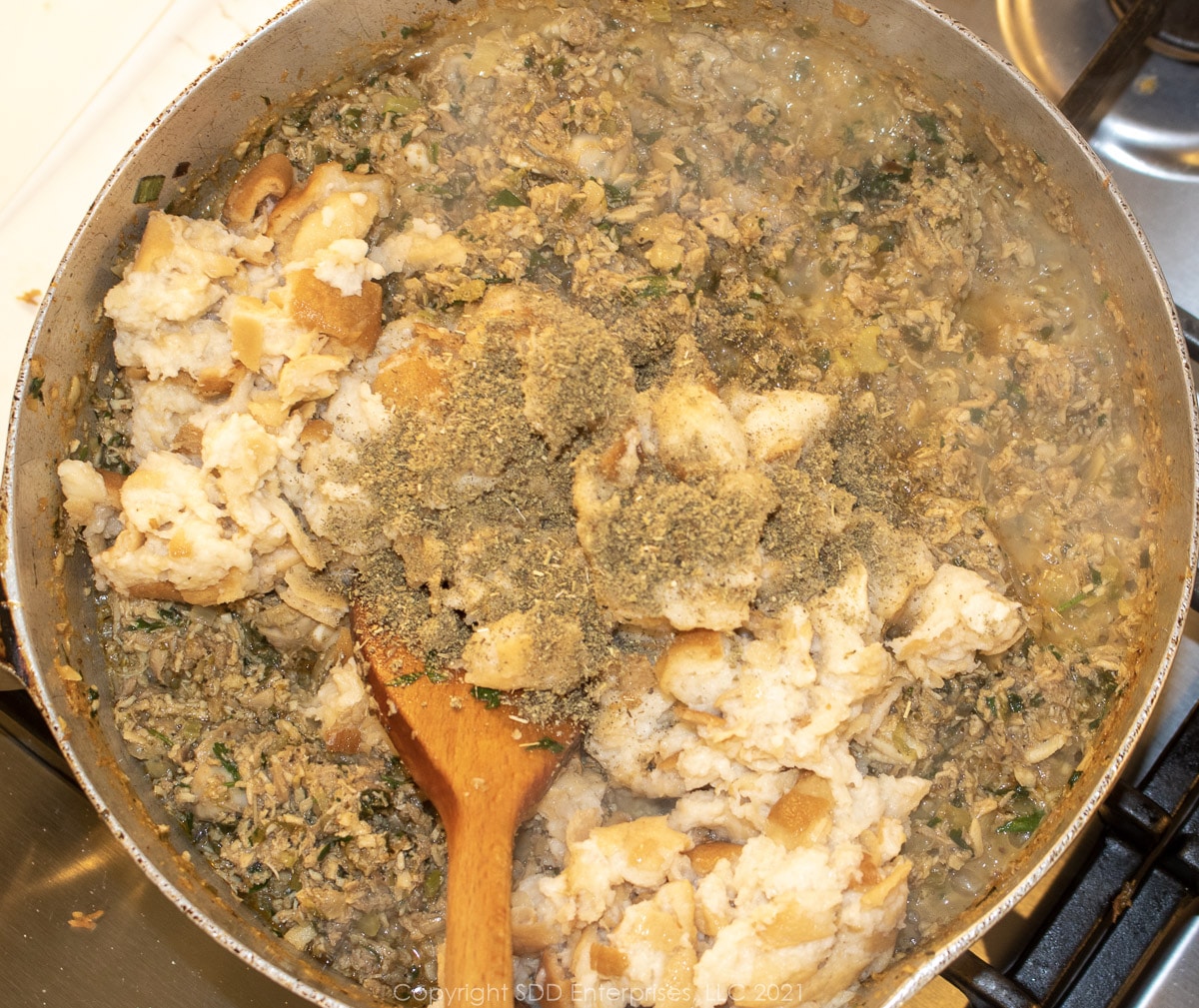
Remove the Dutch oven from the heat and cover. Let sit for about 10 minutes.
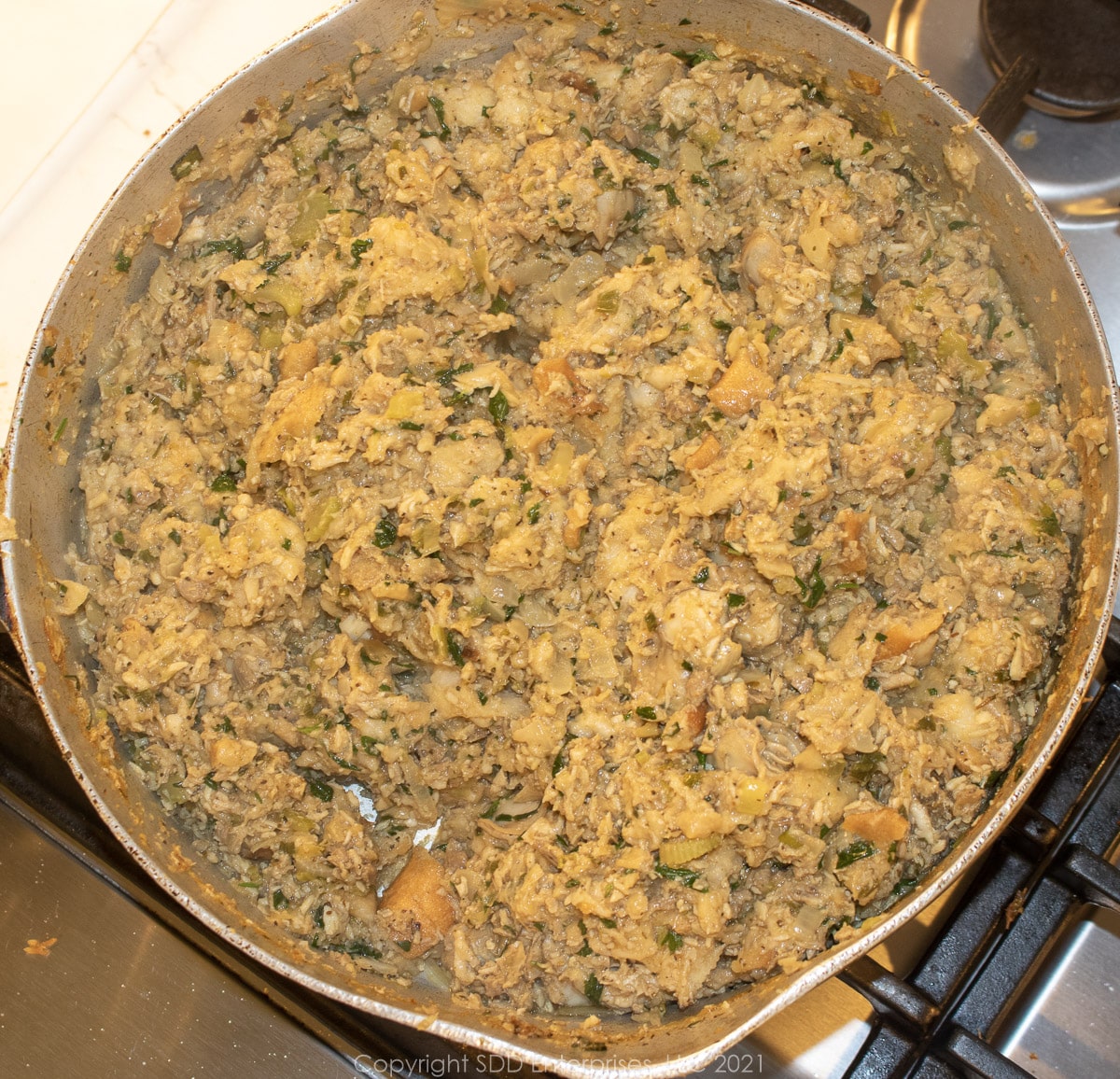
Bake the dressing
What happens in this step? Now we have weaved all these flavors together, it's time that we sealed the deal by baking it into one, homogeneous flavor.
Prepare a baking dish with non-stick spray, oil, or softened butter. Preheat the oven to 350 degrees Fahrenheit. Prepare a baking dish with nonstick spray, oil, or softened butter then fold the oyster dressing into it and spread evenly.
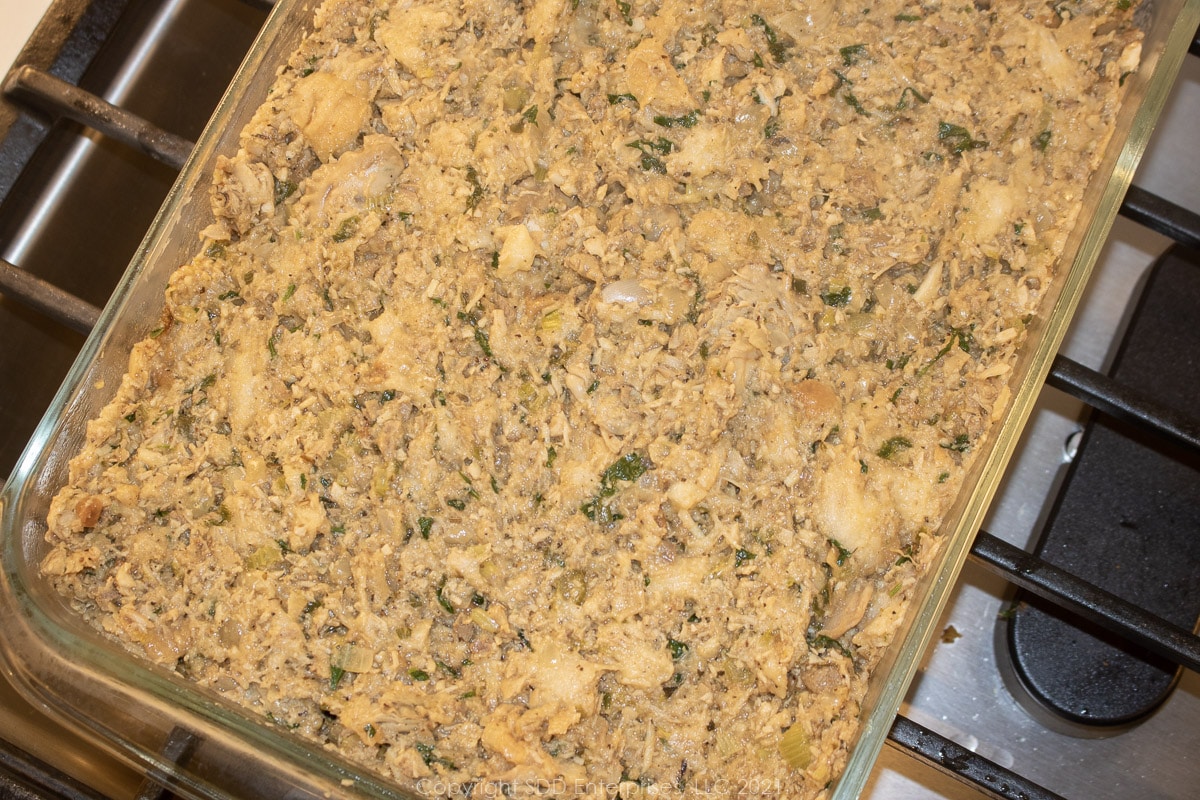
Place the baking dish in the preheated oven and bake for about 30 minutes or until browned and bubbling around the edges.
Remove from the oven and set aside for about 10 minutes.
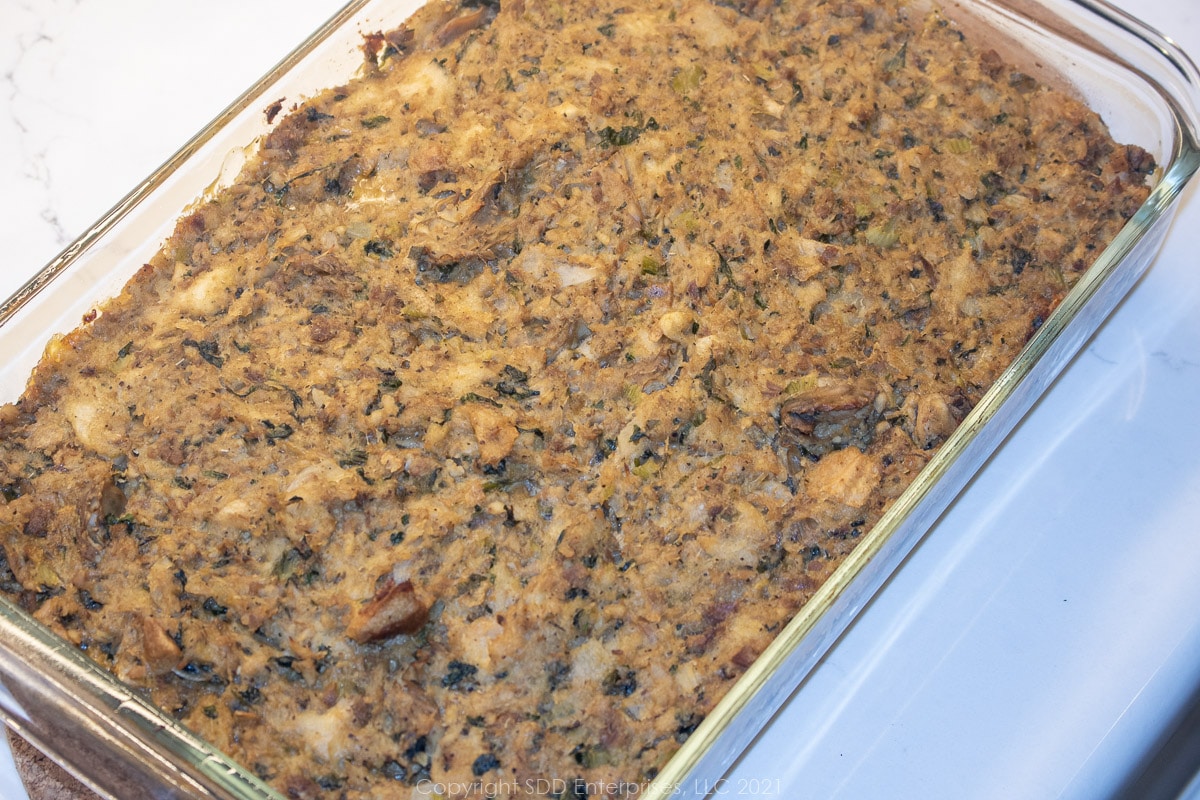
Hints and Tips (FAQs)
You can make this recipe in advance, up to the point of baking. However, the USDA recommends never to refrigerate uncooked dressing due to the risk of bacterial growth. Instead, you can freeze the uncooked dressing. Make sure you have an airtight seal.
Here’s what the USDA says about freezing uncooked dressing:
It is safe to freeze uncooked stuffing; however, the ingredients must be combined, put into a shallow container, and frozen immediately. To use it, do not thaw before cooking. Cook from the frozen state until the stuffing reaches 165°F.
From the USDA’s article, “You’ve Got the Right Stuff(ing)! Tips to Handle Stuffing With Care”.
Leftovers will be fine in the fridge for 3 to 4 days or frozen for 3 to 4 months if held in an airtight container. Reheating the oven, stovetop, or microwave. I find the quality is better if we reheat the amount we are going to eat, rather than reheating the entire amount multiple times. Check out the next question for more about freezing.
The short answer is yes. They are the same thing as far as ingredients go, but the cooking method and the region in which it is prepared may distinguish the difference. As the name implies, a stuffing is cooked inside (stuffed into) the turkey, fowl, or meat while a dressing is cooked in a seperate dish. At the same time, if you are from the deep south, your family tradition is generally dressing, while your cousins from elsewhere in the country can't wait for Grandma's stuffing. Like most regional things in cooking, there are more options than just dressing or stuffing, but we'll save those for another time.
When cooking the stuffing inside the bird, it's important to recognize the food safety aspects of cooking stuffing. Make sure to take extra care that the stuffing deep inside is cooked to the recommended 165 degrees Fahrenheit. Here's what the US Department of Agriculture (USDA) says about this and other food-safety topics with stuffing and dressing.
You can keep this simple by simply using a kitchen strainer. Placing some cheesecloth in the strainer works well but I have also found it very effective to use a double layer of damp paper towels in the strainer. If you don't have a strainer, use a colander with cheesecloth or paper towels.
Grammie likes to use a food grinder with a medium-sized chopper plate. If you don't have or don't feel like messing with a food processor or a food grinder, you can finely chop the poultry meat with a chef's knife.
This is a great opportunity to make a very simple but delicious stock, as well as the best way to cook the chicken thighs and turkey necks. We don't use much of the stock in this recipe, so the extra can be frozen and used in lots of other recipes. If you don't want to mess with it, just cook the poultry, discard the liquid, and substitute this commercial chicken stock. It will be simpler and even less angst. Think about that before you do it because the stock would be helpful in lots of other holiday recipes.
Other Great Dressings from Sweet Daddy D:
Other Recipes from Grammie on First...You Have a Beer:
If you make this recipe:
- Tell us about it in the Comments section below
- LEAVE A RATING ON THE RECIPE-worthy of 5-Stars?
- Questions or Comments? that’s the place!
- SIGN UP FOR OUR EMAIL UPDATES so you don't miss anything!
- Post a picture and share it with your friends on our Social Media:
Yeah You Right!
Recipe
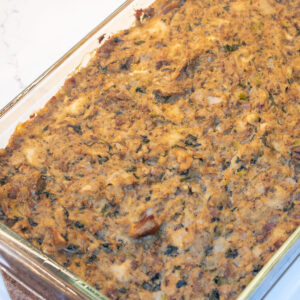
Grammie’s Oyster Dressing
Here's What You Need
For the stock and poultry
- 4 chicken thighs bone-in skin on
- 2 turkey necks
- 2 cups yellow onions
- 1 cup celery
- 1 head garlic
- 6 sprigs parsley
- 1 tablespoon Creole Seasoning
Garni Bag
- 10 Whole Black Peppercorns
- 2 Bay leaves
- 1 teaspoon dry thyme
For the dressing
- 1 quart oysters with juice
- ¼ cup vegetable oil
- 2 cups yellow onions rough chop
- 2 cups celery rough chop
- 1 bunch green onions
- ½ cup parsley chopped chopped
- 6 cups stale french bread ¼ to ½ inch cubes
- 1 cup Chicken Stock as needed-see Notes
Herb and Spice Blend
- 1 tablespoon Creole seasoning
- 1 teaspoon Kosher salt
- 1 teaspoon ground black pepper
- 1 tablespoon sage
Here's What You Do
Prepare the poultry and stock
- Cut the onion in half through the ends, chop celery pinto 2 or 3-inch pieces, slice the garlic head in half crossway.
- Make a garnie bag with thyme, broken bay leaves, and peppercorns. Tie the parsley together with butcher twine.
- Rinse the thighs and pat dry with a paper towel.
- Place a large stockpot over medium-high heat
- When hot, place chicken thighs in a stockpot, skin side down. Brown chicken for about 4 or 5 minutes, then turn over and add the turkey necks. Continue to brown the thighs and necks for about 5 minutes, turning the necks every couple of minutes.
- Remove the thighs and necks, leaving the rendered chicken fat.
- Place the onions and garlic into the stockpot, cut side down. Add the celery. Brown the vegetables for about 5 minutes leaving the onion and garlic cut side down.
- Once browned, add the thighs, necks, parsley, and Garni bag.
- Increase the heat to high. Add 8 cups of cold water, stir.
- Bring the stockpot to a boil, then reduce the heat to a slight simmer. After 15 minutes, skim the impurities off the top.
- Maintain a very low simmer, partially covered for about 1 hour (total), then remove the thighs and set them aside to cool.
- Continue to low simmer the thighs for another 30 minutes. , then remove them and set them aside to cool.
- Strain the liquid and discard the vegetables.
- Once the thighs and necks are cool, remove the chicken skin and pull the meat off the bones. Strip the meat off the turkey necks. Set aside.
- Place the chicken and turkey meat in a small food processor. Sprinkle a little Creole seasoning on top and grind until fine. May need to do this in batches. Set aside. (See Notes)
Make the dressing
- Place a Dutch oven over medium-high heat and add the vegetable oil.
- When hot, add the yellow onions, celery, and green onions and fry until the yellow onions are translucent, 10 minutes.
- Add the ground chicken and turkey meat. Mix well and cook for 10 to 15 minutes, stirring occasionally.
- Add the Herb and Spice Blend (except the sage)
- While the vegetables and chicken meat are simmering, add about 2 to 3 cups of oyster juice to the bread cubes. If you don't have enough oyster juice, use some of the reserved stock. Mix well and set aside, stirring once or twice.
- After the poultry meat has simmered with the vegetables for about 15 minutes, add the raw oysters and the parsley. Stir to mix completely.
- Oysters will release liquid as they cook, so use that to deglaze the pan, if needed.
- Cook until the oysters curl up and the liquid reduces. This should take about 5 to 10 minutes.
- Add about 6 cups of the soaked bread cubes to the vegetables and oysters and mix well to combine.
- Add the ground sage and mix thoroughly. Add the remaining oyster juice (if any) or stock and more bread if needed. Remain on the heat for about 5 minutes.
- Remove the Dutch oven from the heat and cover. Let sit for about 10 minutes.
Bake the dressing
- Prepare a baking dish with non-stick spray, oil, or softened butter. Preheat the oven to 350 degrees Fahrenheit.
- Fold the oyster dressing into the prepared baking dish and spread evenly.
- Place the baking dish in the preheated oven and bake for about 30 minutes or until the top is browned and bubbling around the edges.
- Remove from the oven and set aside for about 10 minutes.

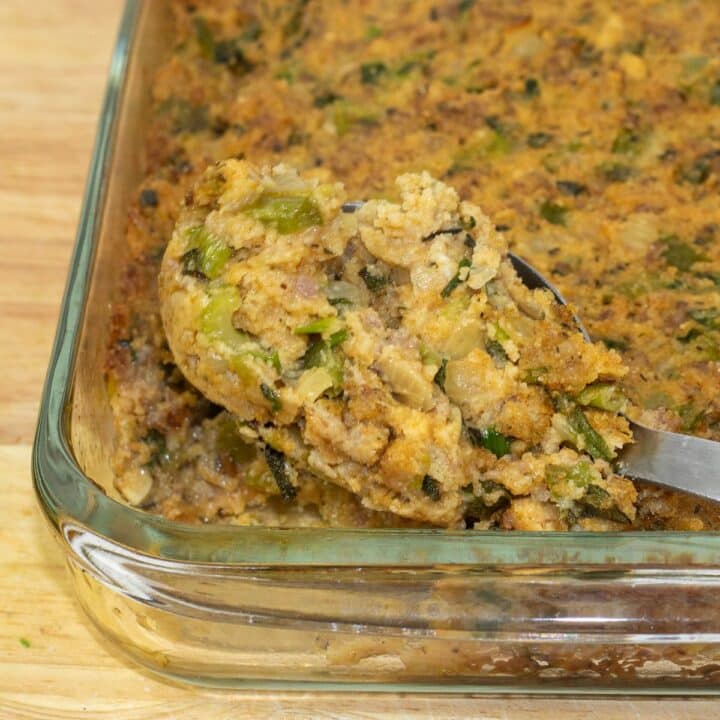
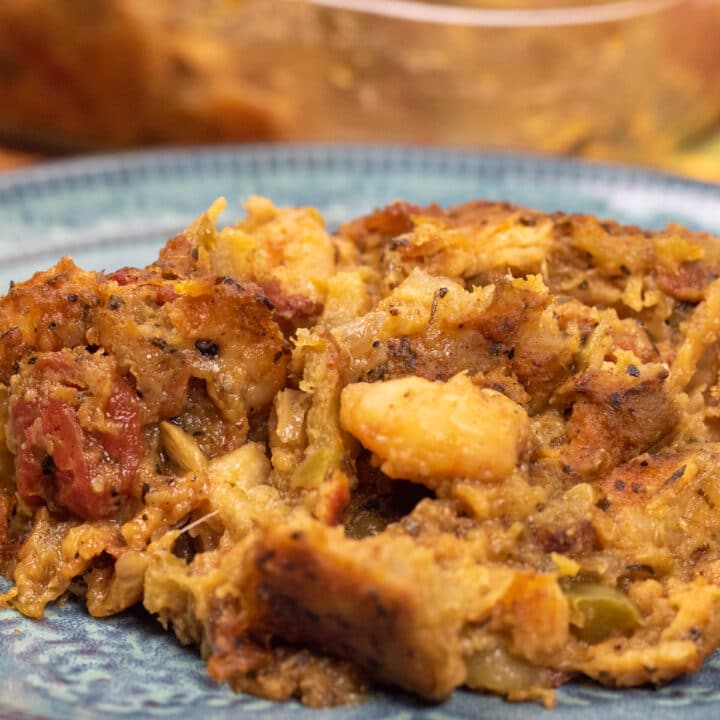
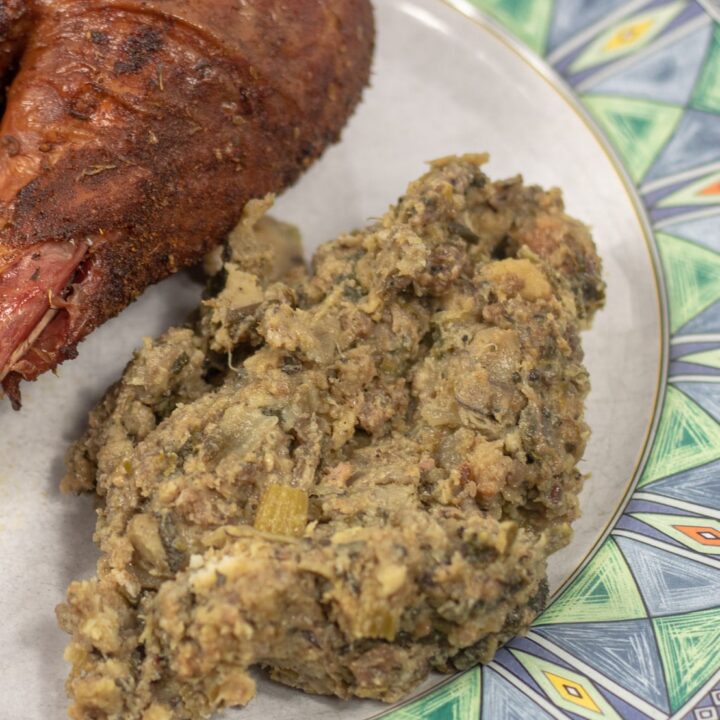
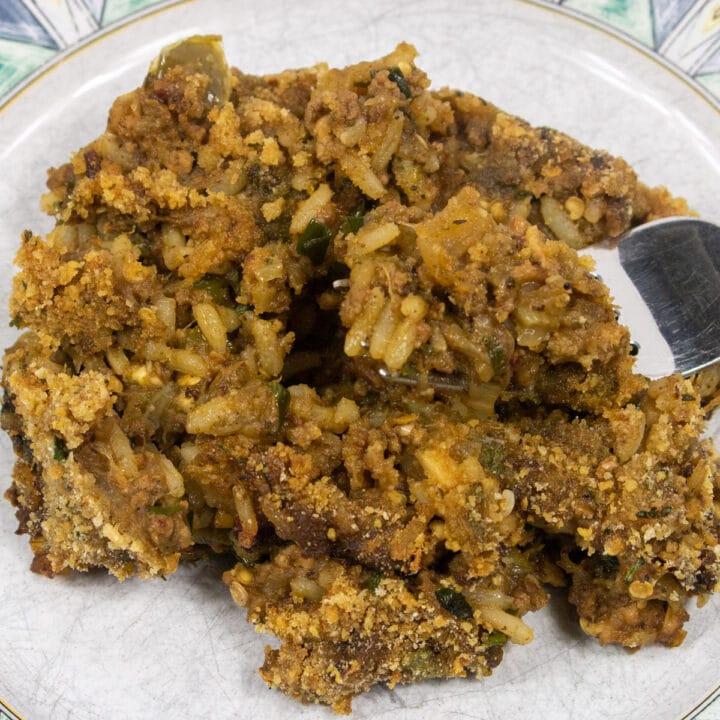
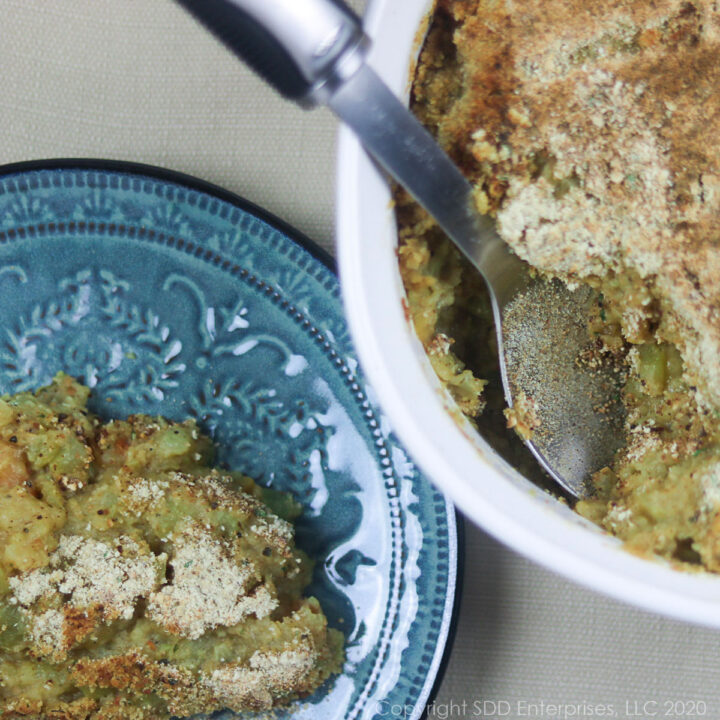
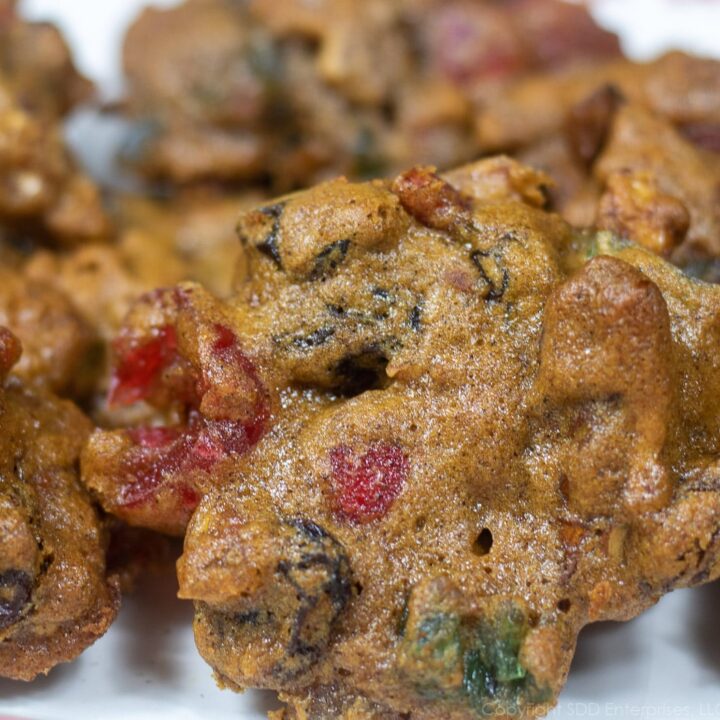
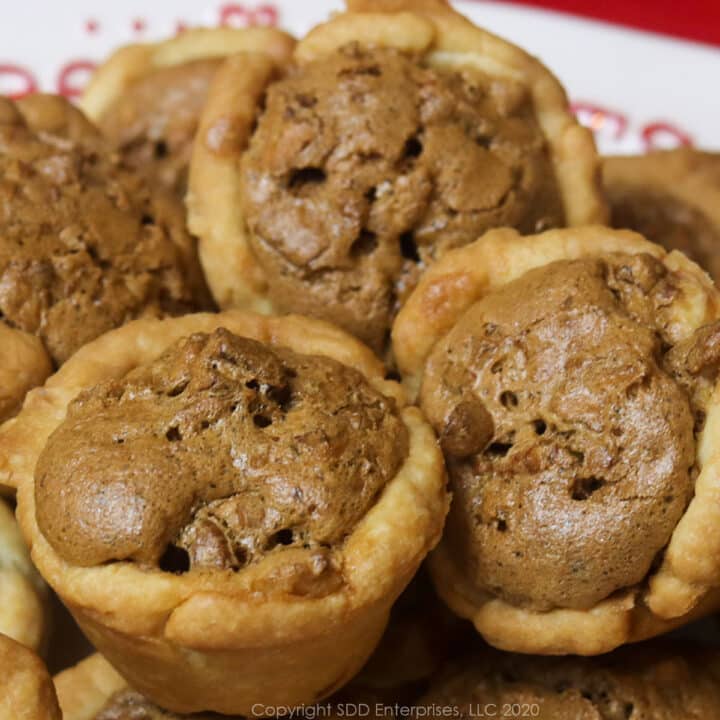
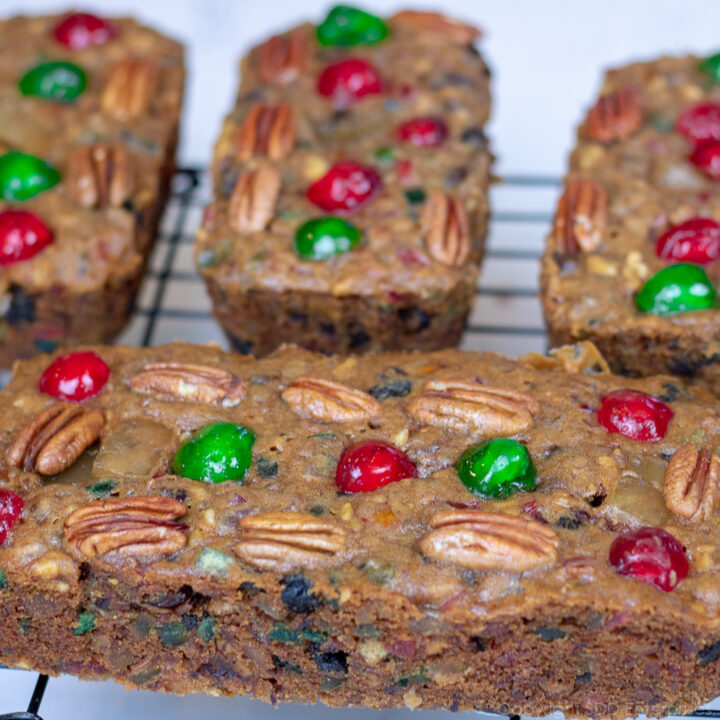
Cindy
Made this last year for the first time and looking forward to it again this year, after I have ma beer 😉
Sweet Daddy D
Yeah you right, Cindy! Enjoy!
William John Weber
Don't mean to be picky, but there is a typo in this recipe under "For the dressing." "Reen onions" should be "green onions."
Sweet Daddy D
Thanks, WJW. I appreciate you reading it so closely and it has been repaired!